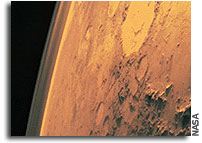NASA MEPAG: Mars Science and Telecommunications Orbiter (DRAFT)

Full document (Word)
Mars Science and Telecommunications Orbiter (DRAFT–Open for comments)
Report of the Science Analysis Group March 2006
Full document (Word)
INTRODUCTION
The Mars Science and Telecommunications Orbiter (MSTO) is a major infrastructure component for the next decade of Mars exploration. MSTO, a Mars Reconnaissance Orbiter (MRO) – class spacecraft, is proposed for launch in 2011 or 2013, depending on the findings of the Mars Program Planning group. MSTO is to provide a combination of science and telecommunications capabilities over nearly a full solar cycle (? 11 years).
This document reports the findings of the MSTO Science Advocacy Group (SAG), which was convened by the Mars Exploration Program Analysis Group (MEPAG) and the Mars Exploration Office at JPL to identify and prioritize areas of Mars atmospheric and surface science objectives for Mars that can be accomplished from orbit on a MSTO like mission.
The MSTO SAG consists of 11 members of the Mars science community with a range of expertise in atmospheric and surface science. In addition, mission architecture and design support was provided by the MSTO Pre-Project group at JPL. The SAG communicated via teleconference and electronic means from December 2005 through March 2006.
The MSTO SAG was asked to include in its deliberations consideration of the following issues related to the Martian atmosphere and surface:
– The evolution of the Martian atmosphere is a subject for which little direct evidence has been found. The timing and rates of atmospheric escape, ancient and present, are important if scientists are to understand the habitability of Mars, particularly the potential for an early atmosphere that was thicker and wetter than the one seen on Mars today.
– There are recent announcements of the possible discovery of methane in the Martian atmosphere. The origin of the trace amounts of methane has been variously suggested to be geologic or biologic. Investigators from the Mars Express mission and Earth-based telescopic measurement programs have speculated about the presence of life, gas seeps, and active volcanism. However, there remain significant unanswered questions about possible sources and sinks of trace gases on the surface and in the atmosphere, as well as their spatial and temporal distributions.
– Two radar sounders are about to return information on the unseen subsurface of Mars: The Mars Express MARSIS is now making measurements of the deep subsurface and MRO SHARAD radar will soon arrive at the planet to observe the structure to depths of several hundred meters. Undoubtedly, by 2011 or 2013 there will be observations and/or discoveries that need to be followed up with shallow subsurface imaging.
In addition, the objectives of the MSTO mission should align with those of MEPAG (“Mars Scientific Goals, Objectives, Investigations, and Priorities”, MEPAG, February 2006), as well as with the Decadal Study (“New Frontiers in the Solar System”).
MSTO would be inserted into Mars orbit in 2012 (2014) and, through a series of aerobraking and energetic maneuvers over a period of 10 or more years, would perform the function of a telecommunications link with other spacecraft during this period, obtain important data on the long-term variability of upper atmosphere density and other EDL-relevant parameters required for subsequent missions, while satisfying the varying orbital requirements of scientific investigations of the upper atmosphere from altitudes as low as 100 km together with the observational needs for temporal and spatial coverage dictated by remote sensing composition measurements of the lower atmosphere. These observations will add a great deal of information about the loss of atmospheric species to space and the determination of the nature, abundance, fluxes, and source locations for trace species. The measure-ments are fundamental for understanding the evolution of the atmosphere, climate, and the presence of habitable zones.
In addition to the atmospheric observations, there are distinct advantages presented by the timing of MSTO to make high spatial resolution measurements of the uppermost few km of the Martian crust to map, for example, the locations of ice deposits, magmatic intrusions, etc. The surface of Mars is covered, to varying degrees, by surficial sediments deposited and modified by aeolian, volcanic, fluvial, impact, or other processes. Many aspects of the geologic and climate history of Mars are hidden beneath these sediments. A radar imaging system can penetrate the mantling materials to reveal buried fluvial, volcanic, impact, and perhaps glacial or ancient shoreline features. In addition, monitoring of the backscatter properties of the near surface through the Martian year may reveal subtle variations due to volatile cycling or migration.
As required by its charter, the SAG considered early in its deliberations the potential for the addition of a subsurface imager/mapper which could make high resolution observations of regions of special interest identified from previous and current missions. It had been thought that a particular advantage to the MSTO atmospheric science would be the ability to use the radar data to aid in interpreting the nature of the sources of molecular constituents of the lower atmosphere that were found to be spatially variable.
It was realized however that, despite the powerful advantages of SAR, there was not sufficient evidence to suggest that the present level of detailed knowledge of the near surface environment of the planet, especially when combined with the refinements to be gained from ongoing MEX and MRO observations, would be inadequate for the purpose of correlating the spatial variability of atmospheric constituents with variations in surface/subsurface characteristics. The SAG concluded therefore that a strong case could not be made for attempting to accommodate a radar system in the MSTO science payload, particularly in view of the large fraction of the spacecraft resources likely to be utilized by the atmospheric science instruments. This decision, of course, does not reflect on the science value of subsurface remote sensing studies made within this same time period.








